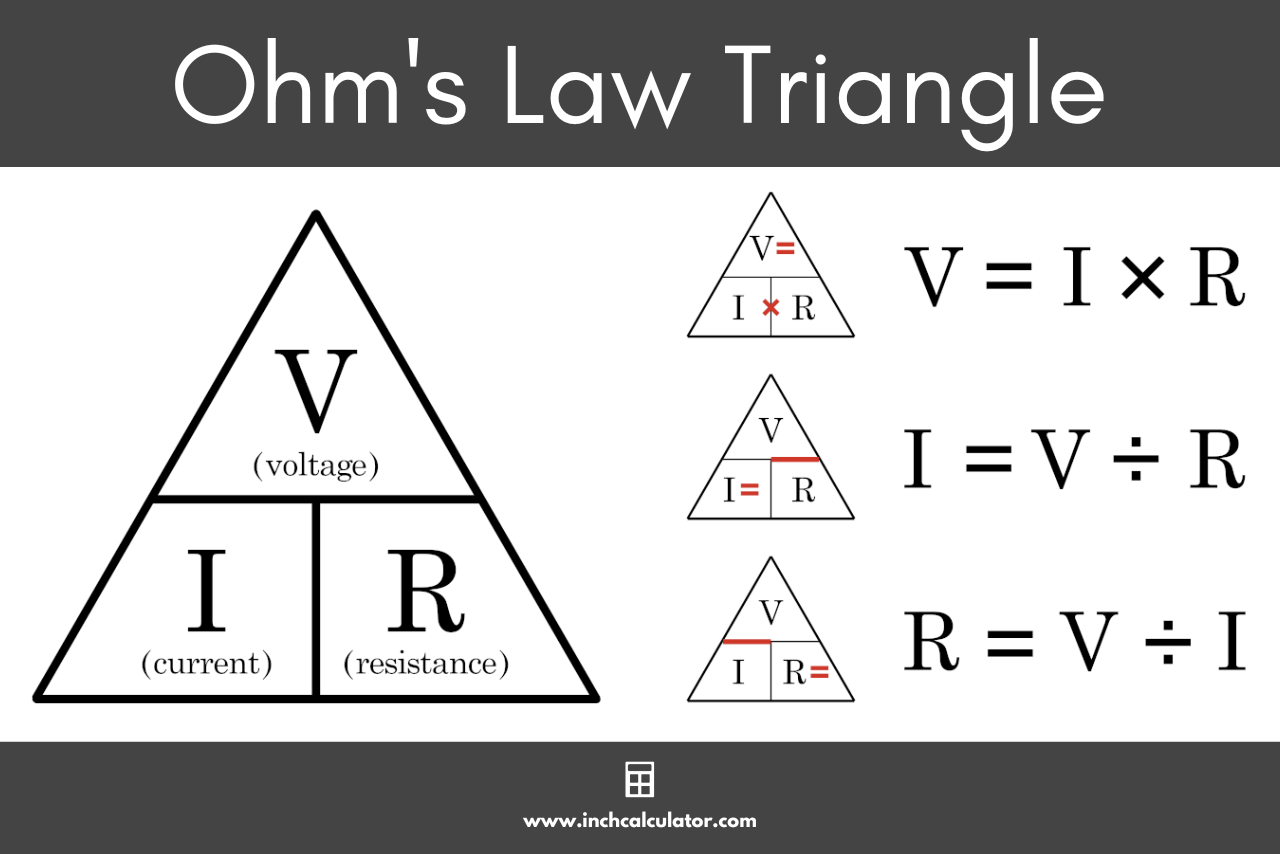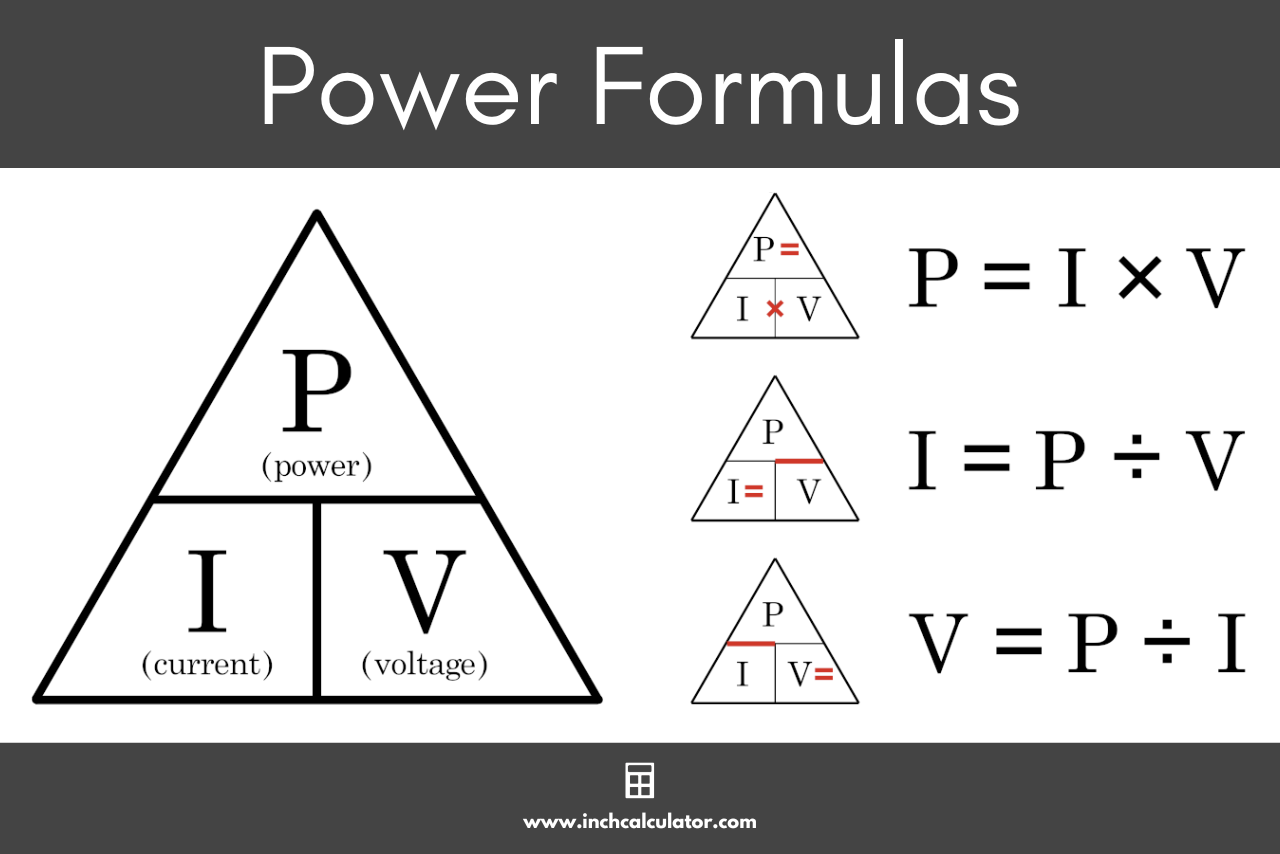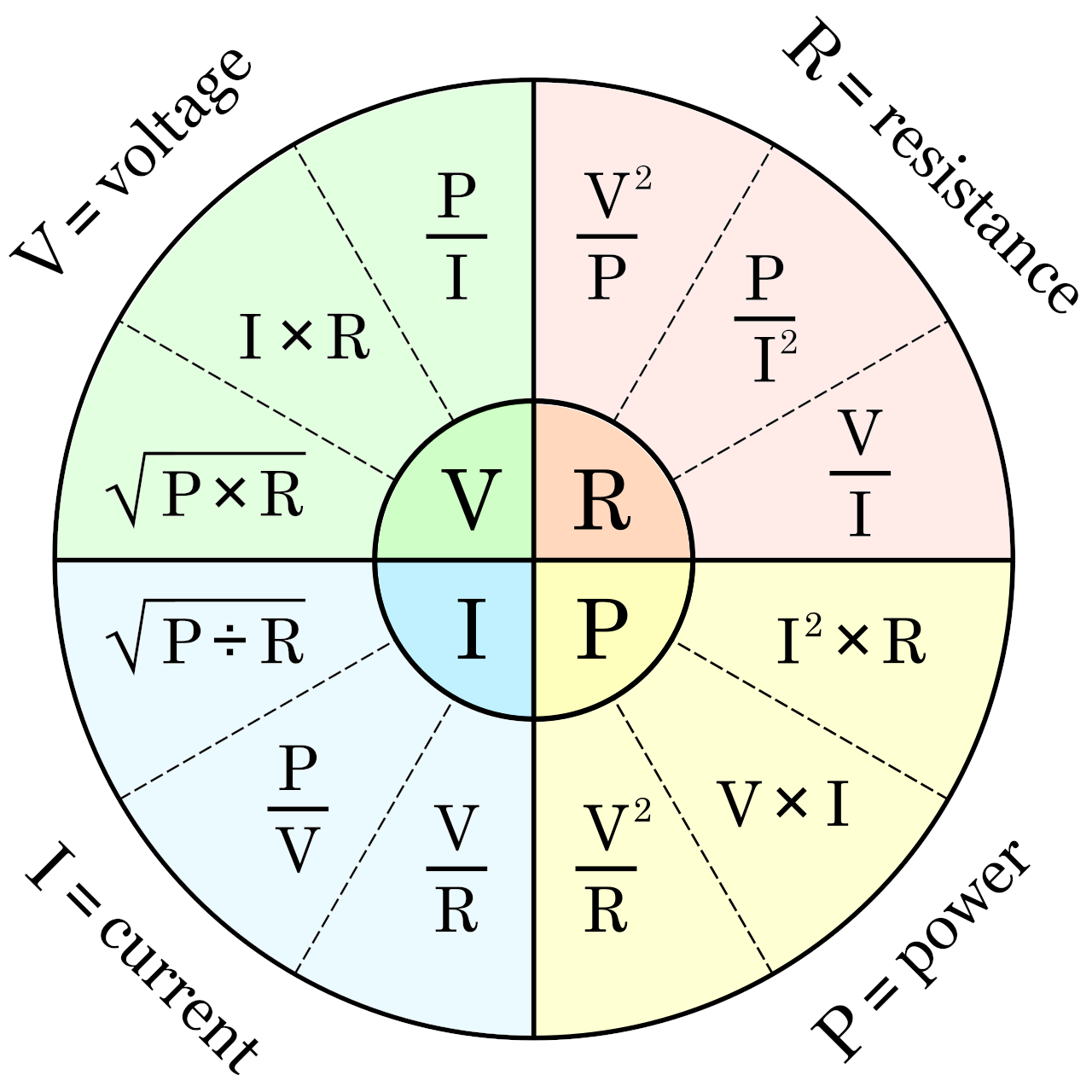Ohm’s Law Calculator
Use Ohm’s Law to calculate the voltage, current, resistance, or power in an electrical circuit. Enter any two values to find the other two.
On this page:
How to Use Ohm’s Law
Ohm’s Law defines the relationship between electric current, resistance, and voltage. More specifically, it states that the current through a circuit element is directly proportional to the potential difference (or voltage) applied to it and inversely proportional to its resistance.[1]
Ohm’s Law allows you to calculate the voltage, current, and resistance of an electrical circuit if you know two of the values. Further, it allows you to calculate power consumption once you know both voltage and current by applying Ohm’s Law.
For example, if you know the voltage and resistance, use the calculator above to find the current using Ohm’s Law, as well as the power consumed by the circuit. Alternatively, you can use the calculator to calculate power and resistance if you know the voltage and current.
Ohm’s Law Formula
The Ohm’s Law formula is I = V/R, where I is the current through a circuit element measured in amperes (or amps), V is the potential difference across the circuit element measured in volts, and R is the resistance of a circuit element measured in ohms.[2]
I = V / R
The formula states that the current I is equal to the voltage V divided by the resistance R.
Components of Ohm’s Law
| Quantity | Unit | Symbol |
|---|---|---|
| Voltage (V) | volt | V |
| Current (I) | ampere | A |
| Resistance (R) | ohm | Ω |
Ohm’s Law Triangle
The Ohm’s Law triangle illustrates how to calculate voltage, current, or resistance. To use it, cover the unit you want to calculate to reveal the formula to solve it.

For instance, to solve for volts, cover the V with your thumb, which reveals that the voltage is equal to I × R.
Watt’s Law Power Formula
Watt’s Law defines the power formula, which states that electric power measured in watts is equal to the product of the electrical current and the voltage.[3] This formula is very similar to Ohm’s Law in that it involves three quantities and can be used to solve for the unknown quantity if two of three elements are known.
We often use the power formula in conjunction with Ohm’s Law to solve for parameters of an electrical circuit.
P = I × V
Thus, the power formula states that power P is equal to the current I times the voltage V.[4]
Power Formula Triangle
Similar to the Ohm’s Law triangle, the power formula triangle illustrates the formula to find power, voltage, or current. Just like before, cover the unit you want to solve to reveal the formula to solve it.
For instance, to solve for current, cover the I with your thumb, which reveals that the current is equal to P ÷ V.

Our watts to amps calculator uses this formula to calculate current from power in electrical circuits.
Ohm’s Law Wheel
We can use Ohm’s Law to calculate the voltage, power, current, or resistance, given that at least two measurements are known. The formula allows us to derive the equations for calculating a quantity given two other known values.
The Ohm’s Law wheel shows all the formulas you can use to find voltage, power, current, or resistance. Note that all of the formulas in the wheel assume a power factor of 1 (relevant when working with AC circuits).[5]

Ohm’s Law Wheel Formulas
The Ohm’s Law wheel illustrates the following formulas:
Voltage Formulas
- Voltage = Current × Resistance
- Voltage = Power ÷ Current
- Voltage = √(Power × Resistance)
Power Formulas
- Power = Voltage × Current
- Power = Voltage2 ÷ Resistance
- Power = Current2 × Resistance
Current Formulas
- Current = Voltage ÷ Resistance
- Current = Power ÷ Voltage
- Current = √(Power ÷ Resistance)
Resistance Formulas
- Resistance = Voltage ÷ Current
- Resistance = Voltage2 ÷ Power
- Resistance = Power ÷ Current2
Formula Examples
We can use the following examples to learn how certain electrical circuit parameters can be calculated:
Example #1 – Let’s calculate the voltage when a current of 10 amps flows through a resistance of 2 ohms.
Voltage = Current × Resistance
Voltage = 10 A x 2 Ω
Voltage = 20 V
Example #2 – Let’s find the power consumed by a device supplied with 5 volts and a current of 2 amps.
Power = Voltage × Current
Power = 5 V × 2 A
Power = 10 W
Example #3 – Let’s find the resistance of a circuit if it consumes 20 watts of power when supplied with 5 volts.
Resistance = Voltage ÷ Current
Resistance = 5 V ÷ 20 W
Resistance = 0.25 Ω
Example #4 – Let’s find the current flowing through a circuit if it consumes 40 watts with a resistance of 10 Ω.
Current = √(Power ÷ Resistance)
Current = √(40 W ÷ 10 Ω)
Current = √4
Current = 2 A
We use Ohm’s Law for many practical applications, such as determining the maximum microwave size or the maximum number of light fixtures a circuit can safely handle without creating a fire hazard.
For example, our lighting cost calculator can help find lighting energy usage, and our electricity cost calculator can help find the costs of powering electric devices.
Use Ohm’s Law to help size an electrical circuit or find out how large of a heater can be safely used on a regular outlet. You might also find our voltage drop calculator to determine voltage drop, the minimum wire size needed, and the maximum wire length for your next electrical project.
Frequently Asked Questions
What do the letters in the Ohm's Law formula mean?
In the Ohm’s Law formula, V represents voltage, I represents current, and R represents resistance.
Georg Simon Ohm created Ohm’s Law in a paper published in 1827,[6] well before voltage, current, and resistance units were defined.
It wasn’t until 1881 that the Volt, Ampere, and Ohm were defined, over 50 years after Ohm’s Law was published. This explains why the letters are not related to modern-day units used in the formula.
What are the Ohm's Law formulas for three-phase circuits?
The Ohm’s Law formulas for 3-phase AC power are slightly different since both the phase constant (√3 ≈ 1.732) and the power factor need to be considered. The Ohm’s Law formula for three-phase circuits is:
current = power ÷ (power factor × voltage × 1.732)
Does Ohm's Law apply to AC or DC circuits?
The Ohm’s Law formulas do apply to both AC and DC circuits. For AC circuits, the impedance needs to be considered. Thus the Ohm’s Law formula for AC circuits becomes:
Z = V/I
Thus, the impedance Z is equal to the voltage V divided by the current I. Impedance consists of a resistive and a reactive component. In the case of DC circuits, only the resistive component is relevant.
How is Ohm's Law used in real life?
The Ohm’s Law formulas form the foundation for nearly all electrical calculations that are used to design circuits for everything from electrical power plants to the circuits used in electronics and computers.
References
- Brandon Mitchell, Robert Ekey, Roy McCullough, and William Reitz, A Fan-tastic Quantitative Exploration of Ohm’s Law, https://aapt.scitation.org/doi/full/10.1119/1.5021431
- National Institute of Standards and Technology, Ampere: The Present, https://www.nist.gov/si-redefinition/ampere-present
- Honore, P., Basic Electronic Circuits Part-1, Analog Circuits, https://www.google.com/books/edition/Basic_Electronic_Circuits_Part_1_Analog/-J6rAgAAQBAJ
- Mike Holt, Electrician’s Math and Basic Electrical Formulas, https://www.mikeholt.com/instructor2/img/product/pdf/1302643872-sample.pdf
- Miller, C., NFPA's Electrical References, National Fire Protection Association, 2004, Jones & Bartlett Learning, 54. https://www.google.com/books/edition/NFPA_s_Electrical_References/raUyIi7i-asC
- Encyclopeadia Britannica, Ohm's Law, https://www.britannica.com/science/Ohms-law





